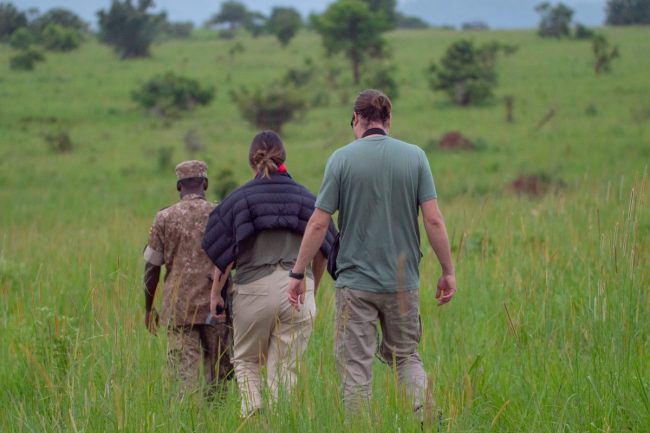Lake Mburo National Park is Uganda’s smallest savannah national park in the western region of the country covering an area cover of 260 square kilometers. It is just 240 kilometers by road from Kampala making it the closest national park to the city center. Lake Mburo National Park is home to over 68 mammal species and also 350 bird species. It is known for being the only national park in Uganda that houses the world’s largest antelope species known as the eland and also the largest population of zebras estimated to be more than 5,000 individual zebras.
Other animals include herds of buffaloes, impalas, bushbucks, topis, waterbucks, warthogs, Rothschild giraffes, and leopards to mention but a few. Bird species in this park include helmeted guinea fowl, blue-billed teal, giant kingfisher, malachite kingfisher, red-necked spurfowl, crested francolin, grey crowned cranes, ring-necked dove, red-eyed dove, African green pigeon, black-belied bustard, common cuckoo, swamp nightjar, alpine swift, common swift, black crake, lesser moorhen, red-chested fluff tail, African finfoot, water thick-knee, crowned lapwing, wattled lapwing, African jacana, African snipe, African skimmer, African open bill, African darter, little egret, black heron, great egret, gray heron, hadada ibis, African sacred ibis, African fish eagle, brown snake eagle, African marsh harrier, green wood hoopoe to mention but a few.
Therefore, one can easily get up close to the above wildlife species by embarking on park activities. These include walking safaris, game drives, horseback riding, cycling safaris, nature walks, birdwatching, and boat cruises along Lake Mburo to mention but a few.
Game walking safari experience
A walking safari in Lake Mburo National Park is an exceptional way to experience and enjoy the park’s wildlife by getting close to several animals and bird species. This activity is done on foot with the guidance of an experienced guide and ranger from the Uganda Wildlife Authority. Several designated trails in the park are followed with the ranger guaranteeing security as you encounter several animals in their natural habitats. Walking safaris in Lake Mburo National Park last for about 2-3 hours as visitors closely watch and learn about various wildlife species as they go by their routine activities. Visitors have the opportunity to take up-close pictures of several animals as well as have photos with animals in their backgrounds for example giraffes, impalas, elands, and many more.
Walking safaris are very safe within this park given that there are no lions or elephants with the occurrence of leopards being rare and occasional. However, it is not allowed to head off for a walking safari in Lake Mburo National Park without a ranger. This is because the park hosts several aggressive animals like Buffaloes and many more. Walking safaris can also be conducted in the local communities adjacent to the park where visitors can experience the Ankole culture and traditions.
The cost of a walking safari in Lake Mburo National Park
Walking safaris in Lake Mburo National Park cost USD 15 per person for foreign non-residents, USD 10 for foreign residents, and UGX 10,000 for East African community citizens per person per day. These costs exclude the park entrance and other activity fees that have to be paid for at the entrance. Park entrances cost USD 40 per person for foreign non-residents, USD 30 for foreign residents, and UGX 20,000 for East African Community citizens.
The best time to do a walking safari in Lake Mburo National Park
Lake Mburo National Park is open to visitors all year round though the best time is during the dry season in June to September and December to February. During this period of the year, the walking trails are dry, accessible, and not slippery like during the rainy season of the year.
A variety of animals tend to concentrate around permanent water sources like Lake Mburo and others which makes it easy for game viewing. The vegetation cover of the entire park is thin and sparse which fosters great views of wildlife even that far away in a distance.

